Cocal vesiculovirus envelope pseudotyped retroviral vectors
a technology of cocal vesiculovirus and pseudotyped retroviral vectors, applied in the field of virology, immunology, molecular biology, can solve the problems of limiting the utility of clinical gene therapy applications, difficult generation of stable packaging cell lines, and disadvantages of using vsv-g to pseudotype retroviral vectors, etc., to achieve the effect of improving serum stability
- Summary
- Abstract
- Description
- Claims
- Application Information
AI Technical Summary
Benefits of technology
Problems solved by technology
Method used
Image
Examples
example 1
Materials and Methods
[0060]Construction of a Cocal Envelope Pseudotype Plasmid
[0061]The deduced open reading frame (ORF) from the published sequence of Cocal envelope (Bhella et al., Virus Res. 54:197-205 (1998); GenBank Accession No. AF045556; SEQ ID NO: 1) was used to generate a human codon-optimized polynucleotide (SEQ ID NO: 3) that was synthesized by Blue Heron Biotechnology (Bothell, Wash.) using GeneMaker technology according to the sequence specified with ClaI and StuI flanking restriction sites. The optimized Cocal ORF was subcloned by standard techniques into pMD2.G kindly provided by Didier Trono, Lausanne, Switzerland (Addgene Plasmid No. 12259) replacing the VSV-G ORF to create pMD2.CocalG.
[0062]Production of Pseudotyped Lentiviral Vector Preparations and Determination of Titer
[0063]The SIN HIV vector plasmids used were pRRLSIN.cPPT.PGK-GFP.WPRE (Addgene Plasmid No. 12252) and pRRLSIN.cPPT.PGK-YFP.WPRE (kindly provided by Luigi Naldini, San Raffaele Telethon Institute f...
example 2
Construction of a Cocal Expression Plasmid and Pseudotyping of Lentiviral Vectors
[0078]A human codon optimized version of Cocal DNA was synthesized based on the amino acid sequence reported by Bhella et al., Virus Research 54:197-205 (1998). The optimized sequence was cloned into the plasmid backbone that expresses the Cocal envelope glycoprotein from a CMV promoter with a human β-globin intron and polyadenylation sequence (FIG. 1). This plasmid backbone is identical to the plasmid backbone for pMD.2G, a VSV-G plasmid routinely used for the production of VSV-G pseudotyped lentiviral vectors.
[0079]SIN lentiviral vectors that express the enhanced green fluorescent (EGFP) protein from a phosphoglycerate kinase (PGK) promoter were generated by transient transfection and pseudotyped with Cocal, VSV-G, or RD114 / TR envelope. Viral titers were determined on HEK 293 cells and also on human HT1080 fibrosarcoma cells. Protamine sulfate and polybrene are cationic polymers commonly used to enhan...
example 3
Cocal Pseudotyped Lentiviral Vectors have a Broad Tropism
[0082]The high titers of Cocal pseudotyped vector preparations suggested that they will be highly effective for many gene transfer and gene therapy applications. The efficiency of transduction was compared for a panel of cell lines and primary cells derived from several tissues that are important targets for gene therapy, and from several species commonly used as preclinical models for gene therapy. FIG. 3 shows the relative transduction efficiency of transformed human cell lines and primary cells derived from blood, retinal epithelia, lung fibroblasts, bone endothelia, skin fibroblasts, stroma from humans, three species of macaques, cow, dog, cat or rat. The Cocal envelope allowed for highly efficient transduction of cell types from all tissues and most species tested with the exception of rhesus (Macaca mulatta) and cynomolgous or crab-eating macaque (Macaca fascicularis) nonhuman primate cells where the transduction rates w...
PUM
| Property | Measurement | Unit |
|---|---|---|
| temperature | aaaaa | aaaaa |
| temperature | aaaaa | aaaaa |
| temperature | aaaaa | aaaaa |
Abstract
Description
Claims
Application Information
 Login to View More
Login to View More - R&D
- Intellectual Property
- Life Sciences
- Materials
- Tech Scout
- Unparalleled Data Quality
- Higher Quality Content
- 60% Fewer Hallucinations
Browse by: Latest US Patents, China's latest patents, Technical Efficacy Thesaurus, Application Domain, Technology Topic, Popular Technical Reports.
© 2025 PatSnap. All rights reserved.Legal|Privacy policy|Modern Slavery Act Transparency Statement|Sitemap|About US| Contact US: help@patsnap.com



